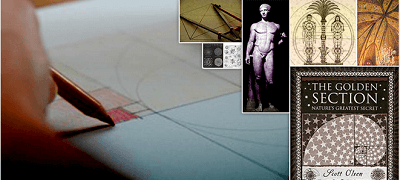This 4 day workshop will cover the foundation principles of Sacred Geometry and the advanced practise of the Canon of the Human Body, and the Divine Proportion & Nature’s Elegant Principles of Design. To those who know how to approach her, Nature will lift her veil revealing a stunning system of elegant aesthetic delights. The Golden Section appearing at the center of it all, may well be the foundation of the most beautiful ratio in Nature, and the very bond that holds everything together through ratio, resonance and self-similar harmony at all levels. Includes a special evening lecture : Divine Proportion & the New Renaissance
Nature Elegant Ratio and the Canon of the Human Body
Nature’s Elegant Ratio and the Canon of the Human Body
With Scott Olsen, Ph.D and Lance Harding Ph.D
This 4 day workshop will cover the foundation principles of Sacred Geometry and the advanced practise of the Canon of the Human Body, and the Divine Proportion & Nature’s Elegant Principles of Design. To those who know how to approach her, Nature will lift her veil revealing a stunning system of elegant aesthetic delights. The Golden Section appearing at the center of it all, may well be the foundation of the most beautiful ratio in Nature, and the very bond that holds everything together through ratio, resonance and self-similar harmony at all levels. Includes a special evening lecture : Divine Proportion & the New Renaissance
THE ELEGANT PRINCIPLES OF DESIGN
To those who know how to approach her, Nature will lift her veil revealing a stunning system of elegant aesthetic delights. The Golden Section appearing at the center of it all, may well be the foundation of the most beautiful ratio in Nature, and the very bond that holds everything together through ratio, resonance and self-similar harmony at all levels.
In this intensive program, students will be introduced to how the Golden Section, the Divine Proportion, is the root source of Nature’s Eurhythmic Principles of Design. Scott and Lance will demonstrate the beauty, wisdom and pervasiveness of this golden mean in everything from DNA, plants, animals, humans and the solar system, to music, quarks, pyramids and hurricanes. Known to Plato and the initiates of classical Greece, the Golden Section’s ubiquitous presence in all things provides the means for our progressive unfoldment into higher states of consciousness, in what the ancients referred to as initiation into the mysteries.
Special evening with Scott and Lance, featuring a visual presentation and lecture/discussion.
LECTURE TOPIC: DIVINE PROPORTION & THE NEW RENAISSANCE
PROFOUND NEW INSIGHTS into the dominating role of the DIVINE PROPORTION is taking the world of both science and aesthetics by storm. For example, on January 7, 2010 teams of physicists collaborating in England and Germany reported their empirical observation of the Golden Section as the principle of symmetry at the heart of Quantum Mechanics. In this visual presentation and discussion we will examine both the ANCIENT TRADITIONS and some of the recent STUNNING DISCOVERIES into the underlying role of a GOLDEN SECTION centered SYSTEM OF DYNAMIC SYMMETRY.
It now appears to be central to PHYSICS (winding number, fine structure constant, quark masses), the PERIODIC TABLE OF ELEMENTS, BIOLOGY (including PLANT PHYLLOTAXIS, GENETICS and DNA structure), HEART physiology, COMPUTER technology, ENCRYPTION, ASTRONOMY, MUSIC, WEATHER TURBULENCE, BEAUTY and the unfolding of CONSCIOUSNESS itself. A deep recognition is arising amongst many scholars, scientists, aestheticians and leading thinkers that the underlying MATHEMATICS OF HARMONY permeates all aspects of life. We are literally on the threshold of a NEW RENAISSANCE in consciousness studies, the sciences, and arts. Perhaps the most striking feature for many is that the SAME GOLDEN PRINCIPLE lies at the HEART of both BEAUTY and OPTIMAL FUNCTION in all fields.
PRINCIPLES OF SACRED GEOMETRY: THEORY & PRACTICE
Scott A. Olsen, Ph.D. and C. Lance Harding, Ph.D.
BOTH 2-DAY WORKSHOPS WILL BE TEAM TAUGHT BY OLSEN & HARDING
Olsen and Harding, long-time students of Keith Critchlow and John Michell, will teach you foundational drawings and geometrical constructions in both plane and solid geometry. Woven around an ancient Egyptian, Pythagorean – Platonic philosophical background and honoring Nature’s fractal principles of design, we will examine the seven transformational (infinite and irrational) numbers of sacred geometry. The fundamentals and application of the Vesica Pisces, Rectangle of Genesis and the Golden Mandala will be explored. We will delve into the significance and application of the three Greek mean proportions. And finally participants will develop a deep understanding of the role of the Golden Section and Fibonacci and Lucas numbers in Nature and principles of design.
We intend to cover the foundational principles of Sacred Geometry in this 2-Day Workshop. It will be a grand introduction for anyone with some experience or even those new to the field. And it will serve as a thorough refresher and extension of important new insights for anyone already familiar with geometric drawings and constructions. We will be integrating into the workshop the basic Pythagorean/ Platonic insights of the most profound Ancient Wisdom taught anywhere on the planet. And we will introduce the use of the Golden Chalice Design Template. Participants will become thoroughly grounded in both geometric drawings and 3-dimensional model constructions. This 1st Workshop will provide all the necessary background and prerequisites to get the most out of the 2nd Advanced Workshop.
Course outline
DAY 1
VISUAL BACKGROUND: PYTHAGOREAN & PLATONIC TRADITION; DIVIDED LINE; PLATO’S GREAT MYSTERY IN THE TIMAEUS
FOUNDATIONAL DRAWINGS: BASIC POLYGONS – TRIANGLE, SQUARE, HEXAGON, PENTAGON, VESICA PISCIS, OCTAGON, DECAGON, & DODECAGON
ROOT & GOLDEN RECTANGLES
THE SEVEN TRANSFORMATIONAL NUMBERS (INFINITE & IRRATIONAL)
FIBONACCI AND LUCAS NUMBERS: NATURE’S METHOD OF DIVINE PROPORTION
MEASUREMENTS OF PARTICIPANTS (VOLUNTARY)
PRIMER ON RATIO, PROPORTION & APPLICATION OF THE THREE GREEK MEANS: ARTITHMETIC, HARMONIC & GEOMETRIC
DAY 2
VISUAL INTRODUCTION: THE NEW GOLDEN PARADIGM: HOW IT MANIFESTS THROUGHOUT NATURE & THE COSMOS
APPLICATIONS OF THE GOLDEN MANDALA, RECTANGLE OF GENESIS & VESICA PISCIS
THE GOLDEN CHALICE OF ORION: WORKING WITH THE DESIGN TEMPLATE AS A TOOL THAT INTEGRATES and
RESULTS OF MEASUREMENTS
VISUAL INTERLUDE: MATHEMATICS OF HARMONY & THE GOAL OF EUCLID’S ELEMENTS
CONSTRUCTING GEOMETRIC SOLIDS: 5 PLATONIC (REGULAR) & 13 ARCHIMEDEAN (SEMI-REGULAR) SOLIDS
OVERVIEW & SUMMATION OF THE PRACTICAL APPLICATIONS OF HARMONY MATHEMATICS
DAY 3
Advanced Principles of Sacred Geometry & THE CANONS OF HUMAN PROPORTION: THEORY & PRACTICE with Scott A. Olsen, Ph.D. and C. Lance Harding, Ph.D.
Our focus will be the ideal Canon of the Human Body using sacred geometry. Participants will become familiar with canons from ancient Egypt (including the Old Kingdom, Amarna, and New Kingdom), Greek and Roman canons, Byzantine Christian, Medieval and Modern canons. Specifically we will examine and employ individual canon studies from Vitruvius (and his 10 measurements of the man in the square and circle), Leonardo da Vinci (geometry of his man in the square and circle), Cesariano (two drawings of man in the square and man in the circle), Desiderius Lenz (his canon of male and female geometry compared with Vitruvius), and Corbusier (golden proportion modular). Finally we will study both Harding’s application of the Golden Mandala to various historical works of art and design, and Olsen’s construction of the Golden Chalice of Orion (fusing together,, , , , and 1/) in one very practical design template.
Note: Workshop participants should bring a sketchpad, straight-edge, good pair of compasses (in American lingo simply called a compass), and pencils (regular & colored), and/ or pens, sharpener & eraser, transparency paper, masking tape and scissors. We will have some extra compasses, straight-edges and pencils available.
In this Advanced Workshop we will penetrate into the very sacred mysteries of the Canons of Human Proportion. These secrets were revealed during the initiatory experiences in the halls and temples of the ancient mystery traditions. But it was absolutely forbidden (on penalty of death) to reveal these tremendous revelations to the un-initiate. Having trained with the best sacred geometers in the world, studied the ancient traditions, and undergone our own inner revelations, we shall weave together what we know of these ancient mystery schools, and the deep insights and epiphanies engendered into the SECRET MYSTERIES OF NUMBER. And because “the whole Universe is enfolded into each part,” as David Bohm used to say, it follows that understanding the human canon allows one to know the Universal Canon. This is one Workshop you will not want to miss!
ESOTERICA 1. SACRED GEOMETRY & INITIATION INTO THE EGYPTIAN & ELEUSINIAN MYSTERIES
TWO CANONS OF EGYPTIAN PROPORTION
POLYCLITUS & THE GREEK CANON OF PROPORTION
VITRUVIUS THE INITIATE: 10 MEASUREMENTS OF MAN IN THE SQUARE AND CIRCLE
THE RENAISSANCE: THE CENTRAL ROLE OF LUCA PACIOLI’S DIVINA PROPORTIONE
CESARIANO, DURER & LEONARDO DAVINCI’S VITRUVIAN MAN
ESOTERICA 2. THE SECRETS OF SYMMETRY & ASYMMETRY: DEEP INSIGHTS FROM SCHWALLER DE LUBICZ’S THE TEMPLE OF MAN, AND THE MAHATMA LETTERS IN THE BRITISH LIBRARY
DAY 4
ESOTERICA 3. HOLOGRAPHIC UNIVERSE, FRACTALIZATION & THE GOLDEN SCIENCES
THE CANON OF PROPORTION OF FATHER DESIDERIUS LENZ
THE PHI CANON OF ADOLF ZEISING
LE CORBUSIER AND THE PHI MODULAR
MODERN CANONS OF KEITH CRITCHLOW & PAUL RICHER
ESOTERICA 4. THE ESOTERIC TETRAKTYS, AND GEORGE HENRY FELT & THE ROOTS OF THEOSOPHY
ESOTERICA 5. DIVINE PROPORTION: RESONANCE, MICROTUBULES AND THE GREAT MYSTERY OF CONSCIOUSNESS & ITS TRANSFORMATION
* Workshop participants should have a sketchpad, straight-edge, good pair of compasses (in American lingo simply called a compass), and pencils (regular & colored), and/ or pens, sharpener & eraser, transparency paper, masking tape and scissors
The Golden Section, Natures greatest Secret By Scott Olsen
SCOTT A. OLSEN, PH.D.
Professor of Philosophy & Comparative Religion at the College of Central College, Scott first received international acclaim by successfully decoding the geometric mysteries of Plato. His recent book, The Golden Section: Nature’s Greatest Secret has received rave reviews, and in 2007 was awarded a 1st place for design by the Bookbinders’ Guild of New York. A life-long student of the Ancient Wisdom, he has studied under physicist David Bohm, world religion expert Huston Smith, sacred geometers Keith Critchlow & John Michell, and esotericist Douglas Baker. Today as a member of the Theosophical Society of America, Scott lectures widely on the Perennial Philosophy (in both its ancient and modern forms) with special emphasis on the Divine Proportion and transformative states of consciousness.
C. LANCE HARDING, PH.D.
Native of Utah, studied art at Brigham Young University; graduated from The Visual Islamic and Traditional Arts Department, now called The Prince’s School of Traditional Art, in London; a student of Professor Keith Critchlow and also studied with John Michell. Dr. Harding is an expert in Sacred Geometry and ancient Canonical Proportions of the Human Body, and has studied extensively the “Man in the Square and Circle” as described by Roman architect Vitruvius and illustrated by Leonardo da Vinci.
STUDY REFERENCES WITH SCOTT
Participants in our workshops would do well to listen to these interview ahead of time.
Scott is writing his new book: “Divine Proportion: The Mathematical Perfection of the Universe.”
At a recent talk and sacred geometry workshop at the Theosophical Society in America, headquarters in Wheaton, Illinois you can listen to the webcast of the lecture: The Golden Section and the Roots of Theosophy (March 10, 2011), online.
Radio interview with Scott Olsen with Gnostic Media (March 19, 2011), which has been highly praised for its content. It can be accessed online.
Scott Olsen decoded Plato And finally, anyone wanting to know how Scott Olsen decoded Plato, solved his Divided Line problem, and figured out the nature of the Indefinite Dyad, as well as, created a template that derives the square root of 2 and the square root of 3 from the Golden Section and its Reciprocal and Square Root [that we will draw in our 2nd Workshop], can go to the following site to access the 2002 paper in Nexus Network Journal of Architecture and Mathematics. The title is, The Indefinite Dyad and the Golden Section: Uncovering Plato’s Second Principle.
Scott’s and Lance’s workshop will draw from the following 4 areas of expertise:
I. SACRED GEOMETRY – we will do geometric drawings & 3D constructions from which one can derive an exhilarating alignment and attunement with the aesthetic principles of the Cosmos itself. We will examine in particular the ratios and proportions developed through the golden mean, root 2, root 3, root 5, and the Fibonacci and Lucas numbers.
II. ANCIENT WISDOM (PERENNIAL PHILOSOPHY) – this knowledge was contained in the teachings of the ancient mystery schools and adapted into the Pythagorean/ Platonic traditions (e.g. as the Principles of the One & the Indefinite Dyad, the Tetraktys, and the Music of the Spheres). We will examine how these traditions understood the mystery of the sacred numbers which were secretly revealed in carefully designed initiatory, transformative experiences.
III. TRANSFORMATIVE STATES OF CONSCIOUSNESS – we will examine how we are in fact hardwired via the divine numbers to experience transformations of consciousness. Understanding the holographic presence of the entire Cosmos potentially within each of us, students will see how resonance, attunement and entrainment using the numbers can lead to peak experiences, and more complete stages of self-identity, fulfillment & inner contentment with life.
IV. PRACTICAL ANALYSIS OF NATURE – Nature’s elegant numbers pervade the entire Cosmos, from top to bottom, from Galactic considerations, down through the Solar System, morphology of humans, animals, insects, plants, minerals, down into the DNA, microtubules, clathrins, subatomic particles and even the quarks themselves. We will see how the Cosmos fractalizes from the above down to the below, demonstrating a Hermetic self-similarity at all levels, in a grand harmonic scheme. Students will examine humanity’s awakening recognition and employment of these numbers in stone circles, tombs, temples, pyramids, sculpture, paintings, and music. And we will consider canons of human proportion as we undergo in-class measurements to observe how each one of us both synchronously and uniquely express the sacred ratios and proportions in our bodies. And finally we shall consider templates and each make a golden calipers so that we can take our wisdom with us for practical application in the future.
CANONS OF PROPORTION
The object of a canon of human (or animal) proportions is to establish an ideal of a beautiful body whether in nature or in artistic reproduction. The aesthetic assumption implicit in the use of such canons in classical Antiquity, diametrically opposed to the aesthetic outlook of the 20th/21st centuries, is that by exactly reproducing the proportions of a beautiful living body and transferring them to stone or bronze (with some compensation in certain cases for distortions of optical perspective) the artist will produce a beautiful work of art. This assumption is present even in Isaiah (44: 13): ‘The carpenter stretcheth out his rule; he marketh it [the image] out with a line; he fitteth it with planes and he marketh it out with the compass, and marketh it after the figure of a man according to the beauty of a man.’
VITRUVIAN MAN: LEONARDO DA VINCI
Vitruvian Man is a famous drawing with accompanying notes by Leonardo da Vinci made around the year 1490 in one his journals. It depicts a naked male figure in two superimposed positions with his arms apart and simultaneously circumscribed in a circle and square. The drawing and text are sometimes called the Canon of Proportions.
The drawing is in pen, ink, and watercolor over metalpoint and measures 34.3 x 24.5 cm. It is currently part of the collection of the Gallerie dell’Accademia in Venice.
According to Leonardo’s notes in the accomanying text, it was made as a study of the proportions of the (male) human body as described in a treatise by the Ancient Roman architect Vitruvius, who wrote that in the human body:
a palm is the width of four fingers
a foot is the width of four palms
a cubit is the width of six palms
a man’s height is four cubits (and thus 24 palms)
a pace is four cubits
the length of man’s outspread arms are equal to his height
the distance from the hairline to the bottom of the chin is one-tenth of a man’s height
the distance from the top of the head to the bottom of the chin is one-eighth of a man’s height
the distance from the hairline to the top of the breast is one-seventh of a man’s height
the distance from the top of the head to the nipples is one-fourth of a man’s height
the maximum width of the shoulders is one-fourth of a man’s height
the distance from the elbow to the tip of the hand is one-fifth of a man’s height
the distance from the elow to the armpit is one-eight of a man’s height
the length of the hand is one-tenth of a man’s height
the distance from the bottom of the chin to the nose is one-third of the length of the face
the distance from the hairline to the eyebrows is one-third of the length of the face
the length of the ear is one-third of the length of the face
The rediscovery of the mathematical proportions of the human body in the 15th century by Da Vinci and others is considered one of the great achievements leading to the Italian Renaissance.
The drawing itself is often used as an implied symbol of the essential symmetry of the human body, and by extension, to the universe as a whole, whether by mathematical order or intelligent design, or both.
It may be noticed by examining the drawing that the combination of arm and leg positions actually creates four different poses. The pose with the arms straight out and the feet together is seen to be circumscribed in the superimposed square. On the other hand, the “spread-eagle” pose is seen to be circumscribed in the superimposed circle. This illustrates the principle that in the shift between the two poses, the apparent center of the figure seems to move, but in reality, the navel of the figure, which is the true center of gravity, remains motionless
The Vitruvian Man
Vitruvius, the architect, says in his work on architecture that the measurements of the human body are as follows that is that 4 fingers made 1 palm, and 4 palms make 1 foot, 6 palms make 1 cubit; 4 cubits make a man’s height. And 4 cubits make one pace and 24 palms make a man. The length of a man’s outspread arms is equal to his height. From the roots of his hair to the bottom of his chin is the tenth of a man’s height; from the bottom of the chin to the top of the head is one eighth of his height; from the top of the breast to the roots of the hair will be the seventh part of the whole man. From the nipples to the top of the head will be the fourth part of man. The greatest width of the shoulders contains in itself the fourth part of man. From the elbow to the tip of the hand will be the fifth part of a man; and from the elbow to the angle of the armpit will be the eighth part of man. The whole hand will be the tenth part of the man. The distance from the bottom of the chin to the nose and from the roots of the hair to the eyebrows is, in each case the same, and like the ear, a third of the face.
-Text from: The Notebooks of Leonardo da Vinci, Vol. 1 (of a 2 vol. set in paperback) pp. 182-3, Dover, ISBN 0-486-22572-0
Leonardo’s vitruvian man
“We know very little about Leonardo’s apprenticeship in Verroccio’s workshop, but the short account provided by Vasari confirms that it included architectural and technological design, according to a concept that was being revived on the model of Vitruvius, as reproposed by Alberti” (Pedretti 14). Having had access to Alberti’s and Vitruvius’ treatises, it is no surprise that Leonardo produced his own version of the Vitruvian man in his notebooks.
This rendering of the Vitruvian Man, completed in 1490, is fundamentally different than others in two ways: The circle and square image overlaid on top of each other to form one image. A key adjustment was made that others had not done and thus were forced to make disproportionate appendages:
“Leonardo’s famous drawings of the Vitruvian proportions of a man’s body first standing inscribed in a square and then with feet and arms outspread inscribed in a circle provides an excellent early example of the way in which his studies of proportion fuse artistic and scientific objectives. It is Leonardo, not Vitruvius, who points out that ‘If you open the legs so as to reduce the stature by one-fourteenth and open and raise your arms so that your middle fingers touch the line through the top of the head, know that the centre of the extremities of the outspread limbs will be the umbilicus, and the space between the legs will make and equilateral triangle’ (Accademia, Venice). Here he provides one of his simplest illustrations of a shifting ‘centre of magnitude’ without a corresponding change of ‘centre of normal gravity’. This remains passing through the central line from the pit of the throat through the umbilicus and pubis between the legs. Leonardo repeatedly distinguishes these two different ‘centres’ of a body, i.e., the centers of ‘magnitude’ and ‘gravity (Keele 252).”
When associated with ideas of beauty ‘proportion’ usually refers to a harmonic relationship among the parts and between any part and the whole of an object, such as a building or a body. It has often been linked with the notion of cosmic harmony. Thus when Leonardo wrote (Trattato 32) that the beauty of a beautiful face consists in ‘the divine proportionality in the composition of its members’, he was thinking in terms of a universal harmony of which proportion in particular things is an intellectually apprehensible reflection. This sort of view was general, though not unopposed or alone in the field, until it gave way to a more subjective conception in the 17th and 18th centuries. Thus Plotinus, for example, said that: ‘Practically everybody asserts that visible beauty is produced by symmetry of the parts towards each other and towards the whole’ (Enneads, 1. 6). He himself, however, refutes this view on the ground that if beauty consists in the proportion of the parts, the simple parts of a beautiful object cannot themselves be beautiful; and this he is not prepared to accept. Furthermore he argues that the idea of proportion cannot be extended to moral and intellectual beauty. Thomas Aquinas ( c. 1225 – 74 ) names ‘due proportion or harmony’ as one of the three ingredients necessary to beauty (Summa theologiae). And the cosmic or theological extension given to the mathematical idea of proportion is evident in the following scholastic definition of the Trinity as ‘Three Persons co-ordinate in a marvellous harmony, the Son being the image of the Father and the Holy Ghost the link between them’ (Ulrich Engelbert, De pulchro). Alberti , who believed that beauty depended on a rational order, nevertheless admitted that ‘there are some whoŠsay that men are guided by a variety of opinions in the judgement of beautyŠand that the forms of structures must vary according to every man’s particular taste’. Dürer , who worked out more systems of proportion than any other great artist, tells how in his youth he heard of a canon of ideal human proportion from Jacopo de’Barbari and from this and Vitruvius (1st century bc ) set himself to work out the ideal canon.
DOWNLOAD NOW!
Read more: archive.is/541S6








